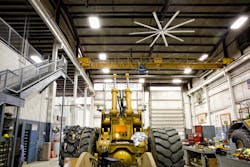Technicians had a hard time staying comfortable in winter in the garage at the Va.-based Luck Stone Corporation, as they worked on the quarry’s heavy equipment. With four large bay doors that constantly open and close, some of the heated air produced from recycled oil and propane was lost to employees. But the bigger culprit in high heating bills and uncomfortable working conditions was the 30' ceiling, which collected rising hot air. Managers tried various ways of getting it down before they found one that made a real difference.
Luck Stone’s problem is common in any facility where trucks, tractors or cars are stored and worked on. In the automotive industry, wide-open interior spaces with high ceilings and huge doors are normal working conditions, whether the job is repairing clunkers, selling Porsches or restoring classic barn finds on a TV reality show.
Keeping these spaces warm in winter without breaking the budget is always a challenge due the troublesome tendency of hot air to rise. The heat from forced-air systems floats to the roof (or stays there if the ductwork registers are high up) while employees at ground level are shivering in their shirt-sleeves on the sales floor and bundled in layers under the lifts.
But more businesses, from Luck Stone in Virginia to TV’s Graveyard Carz gang, are discovering that the most efficient way to solve the problem is through the use of large-diameter overhead fans. Here’s what they’ve learned:
Ups and Downs
Hot air rises. Most people know that. But many don’t know that it forms temperature layers – or strata – throughout a space, with the hottest at the ceiling and the coldest at the floor. This phenomenon is called thermal stratification. Depending on factors like ceiling height, building materials and insulation, temperatures can easily be 20 degrees F to 30 degrees F hotter at the ceiling than the floor.
Stratification occurs because hot air is less dense than cooler air. By rising to the ceiling, the warm air is of no use to employees. The higher the ceiling, the worse the problem; in extreme cases such as 100' tall airline hangars, the ceiling can get so hot that electrical equipment malfunctions. Energy bills soar because of the extra demands on the heater, while people on the ground struggle to stay warm. From a comfort and productivity standpoint, cold employees aren’t happy (or effective) employees.
Why the higher energy bills? Because most thermostats are positioned 4' to 5' off the floor, they register the cooler air at ground level rather than the warm air at the ceiling and constantly send the signal for more heat, forcing the heating system to work overtime.
Luckily, there are ways to combat winter temperatures, including adding insulation and keeping doors closed and cracks sealed. But no matter how airtight a facility is, a large portion of hot air produced by the heaters will rise and be wasted. The most effective way to recycle it is the addition of large-diameter ceiling fans. Also called high-volume, low-speed or HVLS fans, they slowly push the hot air back down from the ceiling and circulate the various temperature layers so that a nearly uniform and vastly more comfortable temperature is created throughout a space. That’s destratification.
Contrary to popular belief, HVLS fans are most effective in a slow forward – not reverse – motion to drive down the hot air. Commonly, people reverse ceiling fans in winter to avoid a draft, but an HVLS fan is designed to run slowly enough not to create a draft, while still providing destratification benefits. Reversing the fan typically just stirs around the hot air at the ceiling and can potentially speed heat loss through the ceiling.
By driving down heat, facilities can drive down costs by as much as 30 percent, because the thermostat is now reading the warmer temperature at ground level and the furnace is not having to consume as much fuel to heat the space.
Cases in Point
At Luck Stone, a single 20' diameter fan brought the heat down, drastically reducing heater use. The company predicted the money saved on propane would pay for the fan and its installation within three years.
And it isn’t just service shops that feel the benefits. At Dondelinger Chevrolet, a dealership in Minnesota, a newly constructed showroom with high ceilings and large windows required an effective way to control winter heating costs – a tall proposition in an area that’s frequently 20-below. The dealership installed four HVLS fans from Big Ass Fans, making the showroom comfortable even on the most frigid days.
“When we installed the first one, it was -28 degrees F outside, and the side of the showroom with the fan felt so much warmer than the side without. You would walk through and immediately feel the difference,” owner DJ Dondelinger said.
And in case you’re wondering about the crew of the Velocity channel’s Graveyard Carz, their new shop in Springfield, Ore., is no longer “a freezer in winter” thanks to two HVLS fans, and the energy bills in the 22,000-sq-ft space are less than half what owner Mark Worman expected, thanks to the fans’ destratification benefits.
“I was prepared for a $1,500-a-month bill (in the new shop), but we haven’t seen half of that,” he said.


